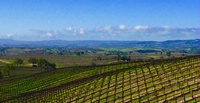A recent opportunity to visit the Paso Robles area for a couple of days of focused tasting and touring revealed to me a region that is forging an identity that transcends what I thought was possible there. At the risk of putting “the bottom line” at the top, the direction that Paso’s vintners are headed in couldn’t be more positive.
As you may be aware, the overarching Paso Robles "macro AVA" has recently been divided into 11 sub-AVA’s, serving to highlight the diversity of weather patterns, soil types and vineyard exposures available within the region.
Wisely, the agreement on the sub-AVA usage for labeling requires that the words Paso Robles appear larger than the district names, ensuring that the larger area gets credited and showing unity of purpose while highlighting the differences that make particular wines special. Not every wine drinker is studying for the Master Sommelier pin, so the broader context helps provide direction for more casual consumers while still providing precision for those desiring more particular detail.

A view from the north end of the Estrella District shows, from right to left, the west-to-east coastal airflow pathways providing the large diurnal temperature swings allowing both optimal ripeness and preservation of natural acidity.
In terms of the current culture among vintners in the area, there’s an ethos accurately conveyed by the cliché that, “A rising tide floats all boats.” It seemed that each winery or chef showed a commitment to common endeavor in addition to individual creativity. Additionally, it is fairly common for wineries to swap fruit from one another’s vineyards — across differing districts — to blend complexity into wines, though often they craft wines from a single district or vineyard to spotlight the unique character provided by single sites.
Although Paso seems more “concerted” than ever these days, there’s still plenty of experimentation and expansion going on across the area, with wineries dabbling in all sorts of ventures: Distilling, vermouth and cider production, sustainable and/or biodynamic practice, on-site dining in all kinds of different ways, animal shepherding, olive orchards… the works. You name it, someone is looking into it, and sharing what they learn along the way. Two-thirds of the area’s wineries produce five thousand cases or less annually, and many are motivated less by monetary ambitions than artistry or lifestyle.
My main takeaway? This is a place where born-and-raised locals make wine alongside immigrants from many other lands, each sharing their varied techniques and aesthetics. The creative vibrancy of the place reminds me of tales of New Orleans at the beginning of the last century, where diverse elements were woven to create jazz music, perhaps America’s greatest gift to the world. I believe Paso Robles is working out a similar achievement in its own genre.
Check out WRO’s “Reviews” page in coming weeks, as I’ll be addressing many especially striking wines from the area, ranging from L’Aventure’s hedonistic blends, to Tablas Creek’s exceedingly food-friendly and long-lived Cal-Rhône examples, to local wunderkind Brian Benson’s full throttle reds, to Rotta’s amazing Zinfandel. Paso’s future is exceedingly bright, but it is likewise true that the present is pretty damned delicious.
46
